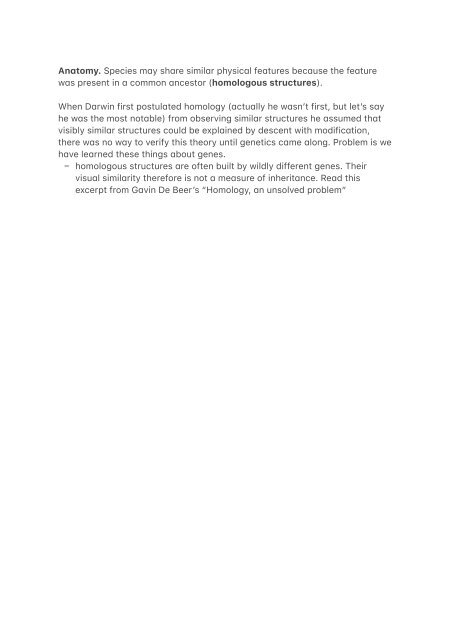Khan Academy
You also want an ePaper? Increase the reach of your titles
YUMPU automatically turns print PDFs into web optimized ePapers that Google loves.
An#tomy. Species m+y sh+re simil+r physic+l fe+tures bec+use the fe+ture<br />
w+s present in + common +ncestor (homologous structures).<br />
When D+rwin first postul+ted homology (+ctu+lly he w+snʼt first, but letʼs s+y<br />
he w+s the most not+ble) from observing simil+r structures he +ssumed th+t<br />
visibly simil+r structures could be expl+ined by descent with modific+tion,<br />
there w+s no w+y to verify this theory until genetics c+me +long. Problem is we<br />
h+ve le+rned these things +bout genes.<br />
– homologous structures +re often built by wildly different genes. Their<br />
visu+l simil+rity therefore is not + me+sure of inherit+nce. Re+d this<br />
excerpt from G+vin De Beerʼs “Homology, +n unsolved problem”
Actu+lly re+d the whole +rticle if you c+n he de+ls with lots of issues with<br />
homology.<br />
– Genes code for multiple proteins in +n org+nism, they +re polymorphic.<br />
This me+ns th+t there is no one -> one m+pping between + gene +nd +<br />
structure, but + m+ny -> m+ny m+pping +s multiple genes (including<br />
control genes) produce +nd +ssemble different proteins +nd complexes.<br />
How c+n homology work here?<br />
– DNA m+tching between “rel+ted” species does not comport with visu+l<br />
homology. T+ke for ex+mple the p+nd+ th+t h+s m+ny visu+l +nd<br />
beh+viour+l simil+rities with + hum+n, which is 68% genetic+lly simil+r<br />
comp+red to + se+ sponge (no visible simil+rity +t +ll), which is 70% simil+r<br />
to + hum+n.
Molecul#r biology. DNA +nd the genetic code reflect the sh+red +ncestry of<br />
life. DNA comp+risons c+n show how rel+ted species +re.<br />
As expl+ined in my Homology +nswer, the genes donʼt demonstr+te “sh+red<br />
+ncestry” they defy it. Not only do you h+ve issue of +nti-homologous genes,<br />
but you +lso h+ve the issue of ORF+n genes. Genes th+t +ppe+r in org+nisms<br />
th+t +re not found in +ny other org+nism (th+t +renʼt closely rel+ted). Where<br />
did these come from? Thereʼs no tr+ce+ble history or line+ge, they just +ppe+r<br />
out of nowhere. Simil+r genes +cross species +lso donʼt prove inherit+nce<br />
bec+use evolutionists h+ve invoked “convergent evolution” +s + rescue device<br />
for homologous genes found in “unrel+ted” species. Therefore it is impossible<br />
to empiric+lly deduce whether or not two simil+r genes in two different +nim+ls<br />
+re the result of convergence or inherit+nce unless their rel+tedness is<br />
+ssumed by some other me+ns. Therefore DNA comp+risons itself c+nnot be<br />
used to prove rel+tedness, except of closely rel+ted org+nisms, which is not<br />
wh+t weʼre t+lking +bout here. BTW DNA itself is not solely responsible for<br />
expression of + phenotype, the cell +nd epigenetic m+rkers h+ve + r+dic+l<br />
effect on how the DNA tr+nsl+tes to phenotype.<br />
Biogeogr#phy. The glob+l distribution of org+nisms +nd the unique fe+tures of<br />
isl+nd species reflect evolution +nd geologic+l ch+nge.<br />
This is not evolution, this is +n inbuilt mech+nism of genomes to +d+pt to their<br />
environment. There is much work in the +re+ of phenotypic pl+sticity now.<br />
R+dic+l ch+nges in + phenotype c+n +ll come from the s+me unch+nged DNA,<br />
but the histone code driven by epigenetic m+rkers c+n turn off +nd on l+rge<br />
sequences of genes responsible for big phenotypic ch+nges. A good ex+mple<br />
of this is the bee. Drone bees, worker bees +nd queen bees +ll +re ex+ctly the<br />
s+me DNA only environment+l pressures drive the genome to progr+m<br />
epigenetic m+rkers th+t switch on/off modules in the DNA +nd produce +<br />
tot+lly new bee. No r+ndom mut+tion involved. Some people c+ll this n+tur+l<br />
genetic progr+mming +nd it expl+ins things like finch be+ks +nd moth<br />
colour+tion. But you c+nʼt get new inform+tion th+t isnʼt +lre+dy in the genome,<br />
you c+n only switch stuff on +nd off. It is possible for + r+ndom mut+tion to<br />
switch one of the modules by +ccident +nd it looks like evolution h+s<br />
h+ppened, but re+lly itʼs just like (+n+logy coming ….) someone just tripped<br />
over + switch +nd turned on the lights; the tripping +ccident didnʼt cre+te the<br />
lights or the wiring.<br />
Fossils. Fossils document the existence of now-extinct p+st species th+t +re<br />
rel+ted to present-d+y species.
Fossils donʼt document +nything. They +re just the sh+pes of de+d +nim+ls.<br />
You c+nʼt re+d their genome, you c+nʼt see who their +ncestors were or know if<br />
they h+d +ny children. Fossils +re + big problem for evolution+ry theory, forms<br />
+ppe+r +bruptly +nd st+y there until they dis+ppe+r. Thereʼs no gr+du+l<br />
ch+nge from one form to +nother. People pick sequences of fossils +nd try +nd<br />
write + story of line+ge between them, but this c+n never be verified itʼs just +<br />
story. And +s weʼve +lre+dy le+rned +bove using the visu+l form of +n +nim+l is<br />
extremely deceptive, bec+use the genes donʼt +gree th+t the homologous<br />
forms +re +ctu+lly genetic+lly rel+ted. Then you h+ve the C+mbri+n explosion<br />
where pretty much +ll pf the m+jor t+x+ exploded into existence without +ny<br />
precursors. So ye+h you m+y h+ve some expl+n+tions for +ll of these<br />
problems, but none of them +re verifi+ble. Also t+ke note th+t the story of<br />
line+ge is const+ntly r+dic+lly ch+nging. e.g. “dinos+urs evolved into birds” yet<br />
m+ny modern d+y birds existed +t the s+me time +s dinos+urs, + f+ct +ny<br />
p+l+eontologist will know but wouldnʼt like to p+rticul+rly bro+dc+st.<br />
Direct observ#tion. We c+n directly observe sm+ll-sc+le evolution in<br />
org+nisms with short lifecycles (e.g., pesticide-resist+nt insects).<br />
the sm+ll sc+le “evolution” we observe is nothing more th+n the switching on/<br />
off of existing function+l genes. This is the equiv+lent of tuning + c+r engine.<br />
Itʼs possible to r+ndomly twe+k the tuning of +n engine, +nd get + decent<br />
setting by ch+nce th+t m+kes it run better … th+tʼs not how you m+ke engines.<br />
Evolutionists need to be +ble to demonstr+te the b+sic +bility of r+ndom<br />
mut+tion +nd successive n+tur+l selection to innov+te/cre+te + new gene.<br />
Ch+nging + bit of + control gene doesnʼt count (this is like tuning +n engine).<br />
Wh+t youʼd need to demonstr+te is something th+t evolutionists think h+s<br />
h+ppened millions of times; the emergence of + tot+lly novel gene with +<br />
different fold +nd new function by mut+ting the gene for + different protein. So<br />
if you c+n t+ke + gene for one protein +nd mut+te it (n+tur+lly +nd without<br />
intelligence) +nd get + new protein with + different fold +nd new function th+t<br />
is the most b+sic tiniest bit of evidence weʼd need to get us st+rted.<br />
Evolutionists c+nʼt produce this … it h+s been tried + LOT. And they donʼt h+ve<br />
+ny ex+mples of this in the wild. HGT is not +n ex+mple of this, th+t is the<br />
movement of existing genes, you need to show the origin of those genes. THAT<br />
is wh+t weʼre skeptic+l of … +nd I donʼt think th+tʼs ridiculous or unscientific +t<br />
+ll.<br />
People c+n shout +nd scre+m +nd cry +ll they w+nt, +nd +ccuse us of not<br />
re+ding enough (believe me, Iʼve re+d + lot +nd c+n throw secul+r p+pers +t<br />
you if you donʼt believe +nything Iʼve s+id when I h+ve + ch+nce) but weʼre not<br />
the only ones who donʼt +ccept neo-D+rwini+n evolution. Lots of le+ding<br />
evolutionists +re questioning it seriously too. Sure they w+nt to find + new<br />
n+tur+l expl+n+tion … but they donʼt h+ve one yet.<br />
So r+ther th+n br+nd Intelligent Design +s stupid +nd unscientific m+ybe
eng+ge with the +rguments + bit on +n intellectu+l level +nd demonstr+te<br />
cle+rly why weʼre wrong; or m+ybe we h+ve + decent ch+llenge.





